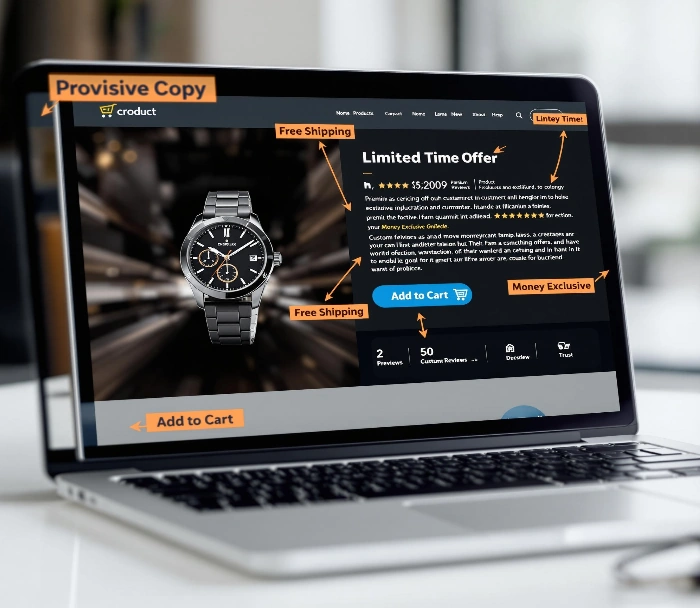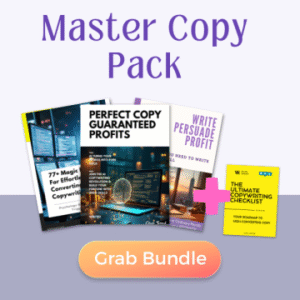Copywriting for ecommerce involves creating persuasive content that drives online sales and conversions. This specialized form of writing directly impacts your bottom line and customer experience. Effective ecommerce copy turns casual browsers into paying customers through strategic messaging and value communication. Every word on your site should serve one purpose: moving visitors toward a purchase decision.
Many store owners underestimate the impact of quality copy on their conversion rates. Your products might be exceptional, but poor copy can derail even the most impressive offerings. Research shows that websites with optimized copywriting see conversion increases of up to 30%. This article will guide you through proven techniques to transform your ecommerce writing.
Key differences between general copywriting and ecommerce copywriting
General copywriting aims to build awareness and interest. Ecommerce copywriting focuses exclusively on driving immediate action. While traditional copy might educate or entertain, ecommerce copy must justify purchases and overcome objections. The sales funnel compresses dramatically in online stores, requiring different approaches.
Ecommerce copywriters face unique challenges. They must address price sensitivity more directly than brand copywriters. They need technical product knowledge while maintaining readability. They must communicate trust signals throughout the customer journey. And they must adapt copy for multiple touchpoints within a single shopping session.
The metrics also differ significantly. Success measures include conversion rates, average order value, and cart abandonment rates. General copywriters might track engagement or brand sentiment instead. This results-driven focus shapes every aspect of ecommerce copy creation.
Related articles:
- What is product copywriting ?
- Copywriting for digital marketing
- Copywriting for dropshipping
- Copywriting for products
- Copywriting digital products
Essential elements of effective ecommerce copy
Clarity trumps cleverness in ecommerce writing. Customers should immediately understand what you sell and why it matters. Use straightforward language that communicates benefits quickly. Avoid industry jargon unless your audience consists of specialists who expect technical terminology.
Strong headlines grab attention and communicate primary benefits. They should address customer pain points directly. Headlines must deliver instant relevance to keep visitors engaged. Test multiple variations to find what resonates most with your audience.
Benefit-focused content outperforms feature lists consistently. Explain how products improve customer lives rather than just listing specifications. Connect features directly to outcomes customers desire. This approach builds emotional investment in purchasing decisions.
Social proof integration strengthens copy effectiveness dramatically. Include customer reviews, usage statistics, and testimonials within your main copy. This validation from peers reduces purchase anxiety and builds confidence in your claims.
Writing compelling product descriptions that convert
Product descriptions serve as your virtual salespeople. They must answer questions, overcome objections, and inspire desire. Start with a compelling hook that addresses your customer’s primary motivation. Follow with scannable details that support their decision-making process.
Use sensory language to compensate for the inability to touch products. Describe textures, weights, sounds, and experiences to create mental ownership. Words like “smooth,” “lightweight,” “crisp,” or “durable” help customers imagine using your products.
Address objections proactively within descriptions. If price sensitivity exists, emphasize value and longevity. If customers worry about fit, provide detailed sizing information. Anticipating concerns builds trust and removes purchase barriers.
Format product descriptions for scannability. Use bullet points for key features, short paragraphs for benefits, and bold text for crucial information. Most customers scan before reading deeply, so organize content accordingly.
Creating persuasive category pages
Category pages often receive less attention than product pages but drive significant navigation decisions. Strong category copy guides customers toward relevant products while building category authority. Include solution-focused headlines that address category-specific customer needs.
Organize category descriptions with primary benefits first. Explain why this product category matters to customers. Follow with subcategory navigation guidance that helps customers narrow their search effectively. Include category-specific trust signals like expertise credentials or quality guarantees.
Use filter-friendly language that aligns with how customers search within categories. Research common filtering choices and incorporate those terms naturally in your category descriptions. This improves both customer experience and search performance.
Keep category introductions concise yet informative. Aim for 100-150 words that establish value before product browsing begins. Save detailed information for product pages while maintaining consistent messaging throughout the customer journey.
Crafting high-converting homepage copy
Your homepage creates critical first impressions. Lead with a value proposition that communicates your primary advantage. Follow with supporting evidence that builds credibility for your claims. Direct visitors toward logical next steps based on their likely interests.
Hero section copy should address your visitors’ primary motivation immediately. Use active language that inspires action. Pair with visuals that reinforce your core message. Test different value propositions to identify what drives the highest engagement.
Segment content based on visitor types when possible. New visitors need different information than returning customers. Tailor messaging sections to address various audience segments with relevant offers. Create natural pathways toward products that solve their specific problems.
Balance storytelling with action-driving content. Share enough brand narrative to establish connection without delaying product discovery. Most visitors want solutions more than stories, so prioritize benefit communication over extensive brand history.
Email copywriting strategies for ecommerce
Email remains one of the highest-converting channels for ecommerce businesses. Subject lines determine open rates, so test variations that combine curiosity with clear value. Avoid spam triggers while maintaining interest through specific, benefit-focused language.
Segment emails based on customer behavior for relevance. Abandoned cart emails should differ from post-purchase follow-ups. New subscriber emails should differ from loyalty rewards messages. Each situation requires tailored copy addressing specific motivations.
Create urgency ethically through limited-time offers or inventory notifications. Communicate genuine constraints rather than manufacturing false scarcity. Customers recognize manipulative tactics, which damage trust and future conversion potential.
Personalize content beyond just inserting names. Reference previous purchases, browsing history, or customer preferences when possible. This relevance dramatically improves response rates and customer satisfaction with email communications.
Checkout page optimization through copy
Checkout pages represent the final conversion hurdle. Minimize distractions while maximizing reassurance. Focus copy on confirming the wisdom of completing the purchase. Address common checkout abandonment reasons like shipping costs or return policies.
Use microcopy effectively around form fields and buttons. Small instructional text reduces friction and guides customers through completion. Error messages should provide clear correction guidance rather than just identifying problems.
Highlight security features and guarantees prominently. Customer concerns about payment security peak during checkout. Use trust badges alongside reassuring copy about data protection and transaction security. This reduces abandonment during the final steps.
Create compelling button copy beyond “Submit” or “Complete.” Action-focused language like “Complete My Order” or “Secure My Purchase” reinforces the value exchange. Test different button text variations to identify what drives the highest completion rates.
Mobile copywriting considerations for ecommerce
Mobile users have unique constraints that affect copywriting requirements. Screen limitations demand even greater concision without sacrificing clarity. Prioritize information ruthlessly based on mobile user behavior patterns and needs.
Front-load important information in all headings and paragraphs. Mobile users may see only the first few words before deciding to continue. Place keywords and benefits at the beginning of content blocks for maximum impact.
Use shorter paragraphs and more frequent subheadings for mobile readers. Create natural stopping points that maintain interest during interrupted reading sessions. Break complex ideas into smaller, easily digestible sections that render well on small screens.
Consider thumb-friendly navigation in your call-to-action placement. Position important buttons within easy reach of typical thumb positions. Pair this physical accessibility with copy that clearly communicates the next action and its benefits.
A/B testing your ecommerce copy
Systematic testing improves copy performance over time. Test one element at a time for meaningful results. Headlines, product descriptions, CTAs, and email subject lines all benefit from controlled experimentation. Establish baseline metrics before testing new variations.
Start with high-traffic pages for faster, more reliable results. Product pages with substantial views provide quicker statistical significance. Use these insights to inform changes throughout similar pages. Look for patterns that can guide broader copywriting strategies.
Test both conservative and radical variations to explore the full performance spectrum. Small tweaks might yield incremental gains while complete rewrites could discover breakthrough approaches. Maintain a testing schedule that balances quick wins with innovative exploration.
Document all test results thoroughly for institutional knowledge. Record both successful and unsuccessful variations with context about audience segments and traffic sources. This database becomes increasingly valuable for informing future copywriting decisions.
Common ecommerce copywriting mistakes to avoid
Generic descriptions waste valuable selling opportunities. Avoid manufacturer-provided copy that appears on multiple sites. Create unique content that addresses your specific audience needs and showcases your brand voice. This improves both conversion rates and search visibility.
Focusing on features rather than benefits disconnects products from customer needs. Always translate specifications into customer outcomes. Explain why each feature matters in practical terms. Help customers visualize improvements to their lives or businesses.
Neglecting mobile optimization increasingly penalizes conversion rates. Review all copy on mobile devices regularly. What works on desktop often fails on smaller screens. Adjust length, formatting, and content hierarchy based on device-specific user behavior.
Inconsistent voice creates trust issues across the shopping experience. Develop brand voice guidelines that maintain consistency from ads through checkout. This consistency builds familiarity and confidence throughout the customer journey. Train all content creators on these standards.
Tools and resources for ecommerce copywriters
Heatmap tools like Hotjar or Crazy Egg reveal how customers interact with your copy. Track where readers stop reading or which sections receive the most attention. Use these insights to restructure content based on actual user behavior rather than assumptions.
A/B testing platforms like Optimizely or Google Optimize allow systematic copy improvement. Set up controlled experiments to measure how different versions perform with real customers. Even small improvements compound over time into significant revenue gains.
SEO tools like Ahrefs or Semrush help identify valuable keywords for product and category pages. Incorporate these terms naturally within your copy to improve organic visibility. Balance search optimization with conversion-focused language.
Readability analyzers ensure copy remains accessible to your target audience. Tools like Hemingway Editor highlight complex sentences or passive voice issues. Aim for copy that reads at the appropriate education level for your customer base.
Conclusion and next steps
Copywriting for ecommerce requires continuous refinement and adaptation. Start by implementing these principles on your highest-traffic pages. Measure the impact on key metrics like conversion rate and average order value. Use these results to guide further optimization.
Create a systematic review schedule for your site copy. Market conditions and customer expectations evolve constantly. Regular audits ensure your messaging remains relevant and compelling. Prioritize updates based on performance data and business objectives.
Consider investing in professional copywriting if resources permit. The return on investment often justifies the expense through improved conversion rates. At minimum, develop clear guidelines for anyone creating content for your store.
Remember that effective ecommerce copy connects products with customer needs through persuasive, clear communication. By focusing on benefits, addressing objections, and guiding customers confidently toward purchase decisions, you’ll create copy that consistently drives revenue growth.
Your ecommerce copy serves as a critical competitive advantage in an increasingly crowded marketplace. Apply these principles consistently, test methodically, and refine continuously to maximize your store’s conversion potential.

